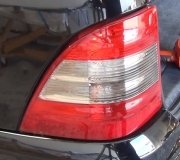The reason I asked for clarification is this is a very basic RWAL system that only uses one speed sensor in the top of the rear differential. The controller is only capable of storing one diagnostic fault code at a time, and I have never seen a scanner or code reader other than Chrysler's DRB2 that can read the codes and erase them. That may have changed by now, but when I was at the dealership in the '90s, Snapon, for one, didn't see much of a market for adding it to their capabilities. Even disconnecting the battery doesn't erase the fault code.
Based on the red warning light being on, my guess is a parking brake cable is rusted partially-applied. Since rear drum brakes are "self-energizing", a dragging parking brake will make that brake self-apply when trying to drive forward. The truck will usually be able to move rearward. The first clue is the red light will turn off if the parking brake pedal is pulled up by hand.
The second clue, while this wasn't actually stated, is it is implied the warning lights do not turn on at times. If a hard defect occurs, the yellow ABS warning light will stay on all the time. It only turns on intermittently when the red warning light turns on. There's three inputs for the red light. Those are the parking brake switch, the low-fluid level switch in the reservoir, and the pressure differential switch. That red light is an input to the ABS controller. That controller turns the yellow warning light on and turns the ABS system off any time the red light is on. It doesn't know why the red light is on. It only knows there's a pretty good chance it can't perform properly, either due to a leak in half of the system, loss of brake fluid in general, or a drum brake that won't cycle and release properly.
This system used a "dump" valve and an isolation valve up by the master cylinder. It could block additional brake fluid pressure to the rear wheels, and it could bleed off some of that pressure if it saw them slowing down too quickly. There was no pump to reapply pressure as there is in 4-wheel-ABS systems, so no defect could apply the brakes. A quick way to know this is an RWAL system is the brake pedal will gradually drop closer to the floor when a rear-wheel skid is initiated.
The 4-wheel-ABS system didn't show up until the '94 model year. Those did use a pump to reapply pressure. The clue there is the brake pedal can get pushed back toward the driver while it's modulating brake fluid pressure. You'll feel vibrations in the brake pedal too. These 4-wheel systems didn't become common until around the '95 to '97 model years. I don't remember working on this system. I do remember as late as 1995 the RWAL system still needed the DRB2 to read and to erase fault codes. The next version, DRB3, might do that too with one of the plug-in "Supercards" that lets it work on models as far back as 1983.
The bottom line is this sounds like while there might be a problem with the ABS system, it is likely not the cause of the failure to move. It sounds like a symptom or clue.
Wednesday, August 4th, 2021 AT 6:28 PM



